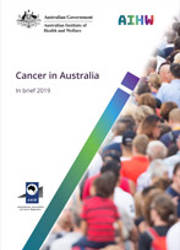Summary
Cancer is a major cause of illness in Australia and has a substantial social and economic impact on individuals, families and the community. In 2019, it is estimated that 144,713 people will be diagnosed with cancer and 49,896 people will die from cancer.
This booklet presents key findings from Cancer in Australia 2019, the 19th in a series published by the Australian Institute of Health and Welfare (AIHW) which provides the latest cancer screening, incidence, hospital, survival, mortality and burden of disease statistics. The full report and comprehensive online tables are available to download free at Cancer: Reports.
What is cancer?
Cancer is a term used for diseases in which abnormal cells divide without control and can invade nearby tissues. Cancer cells can also spread to other parts of the body through the blood and lymph systems. Cancers can develop from most cell types and are distinguished from one another by the location in the body where the disease began (for example, lung) or by the cell type involved (known as histology).
Terminology used in this report
Incidence rate: the number of new cancers diagnosed per 100,000 people during a year. All incidence rates in this report are age standardised to the 2001 Australian Standard Population, except for rates by age groups, which are age specific.
Hospitalisation (or separation): an episode of care that either begins with admission and ends with discharge, transfer or death, or is defined by a change in care type, such as from acute care to rehabilitation.
Mortality rate: the number of deaths per 100,000 people for which the underlying cause was cancer. All mortality rates in this report are age standardised to the 2001 Australian Standard Population, except for rates by age groups, which are age specific.
Prevalence: the number of people alive who have previously been diagnosed with cancer within the referenced time frame e.g. 5 years for 5-year prevalence.
Relative survival: the average survival experience. It compares the survival of people diagnosed with cancer with that experienced by people in the general population of equivalent age and sex in the same calendar year.



